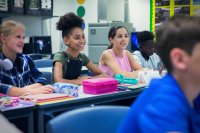How to Promote Social, Emotional, and Character Development
There’s no need for funding or special training to bring these approaches and strategies into your classroom right away.
Your content has been saved!
Go to My Saved Content.As more and more schools adopt social and emotional learning standards and realize that students’ college and career success depends strongly on their social, emotional, and character development (SECD), teachers are looking for guidance as to how to bring SECD into their classrooms every day. Whether or not your class has a systematic curriculum, students benefit when SECD is part of academics and classroom conversations and procedures.
Members of our Rutgers SECD Lab have the good fortune of visiting many schools in New Jersey, across the nation, and internationally. Culled from our observations of what teachers are doing in many schools, each of the eight areas below includes a list of strategies that you can introduce into classroom and school routines without any funding or in-service training.
1. Be a positive role model in your words and actions:
- calm yourself down when you’re upset,
- use a problem-solving process to help you make decisions,
- reflect on what you have done and try to learn from it, and
- live a life of social commitment and concern for others.
2. Respond to real-life situations by:
- showing measured reactions to students’ behaviors,
- offering students choice and voice,
- providing opportunities for students to give feedback to each other,
- noting the consequences of their choices, and
- providing second chances when appropriate.
3. Read to students and use literature:
- share biographies and autobiographies to highlight character virtues and use of positive SECD skills,
- examine current role models and those from history,
- work with students to examine the advantages and disadvantages of the internet, and
- explore the work of scientists, mathematicians, artists, musicians, first responders, public officials, and those working in other fields, the problems they were trying to solve, and the decisions they made along the way.
4. Encourage writing as a means of expression by:
- teaching students a variety of emotion words to use in their writing,
- encouraging students to think about choices and consequences and effects on self and others,
- identifying students’ goals and aspirations and how these connect to their everyday behaviors, and
- having students use a personal journal with or without feedback to record interests, needs, ambitions, feelings, attitudes, and emotions.
5. Have conversations about character by:
- relating personal and family stories,
- sharing and listening to students’ experiences,
- highlighting examples of kindness and of caring students in and around the school,
- discussing real-life and fictional dilemmas and the choices and values they require,
- reflecting on what motivates people and why they act the way they do, and
- commenting on and improving the critical thinking skills of students, including time management, goal-setting, questioning, brainstorming, problem-solving, and ethical decision-making.
6. Advocate for participation and service in school and in the community by:
- providing many opportunities for contribution to the everyday classroom community,
- encouraging students to become involved in school activities,
- recognizing when students volunteer and help others,
- encouraging students to engage in cultural events and share what they experienced,
- encouraging involvement in physical activities such as sports or exercise programs or other co-curricular activities, and
- encouraging classroom and school community service projects.
7. Promote mindfulness in students by:
- having mindful moments in your classroom at the start of the day and during transitions,
- giving time for reflection at the end of the school day, or the end of a class or unit, about what was learned, how students’ learning was supported, and what questions students have for the future, and
- teaching a self-calming strategy students can use when they anticipate or find themselves upset in a situation, such as before tests and performance situations or when in a conflict with peers.
8. Help students make better decisions about their health and relationships by:
- having them set goals for something they can do to improve their health (nutrition, personal hygiene, sleep patterns), and
- having them set goals for something they can do to improve their behavior (controlling strong negative emotions, stopping harassment and intimidation of others, acting more kindly and helpfully, and being more honest).
The more frequently you integrate these strategies into the learning and teaching as routines, the more habitual they will become for students. When this happens, you will be building students’ social, emotional and character development in ways that will nourish and create positive habits in their interpersonal and intrapersonal relationships.
